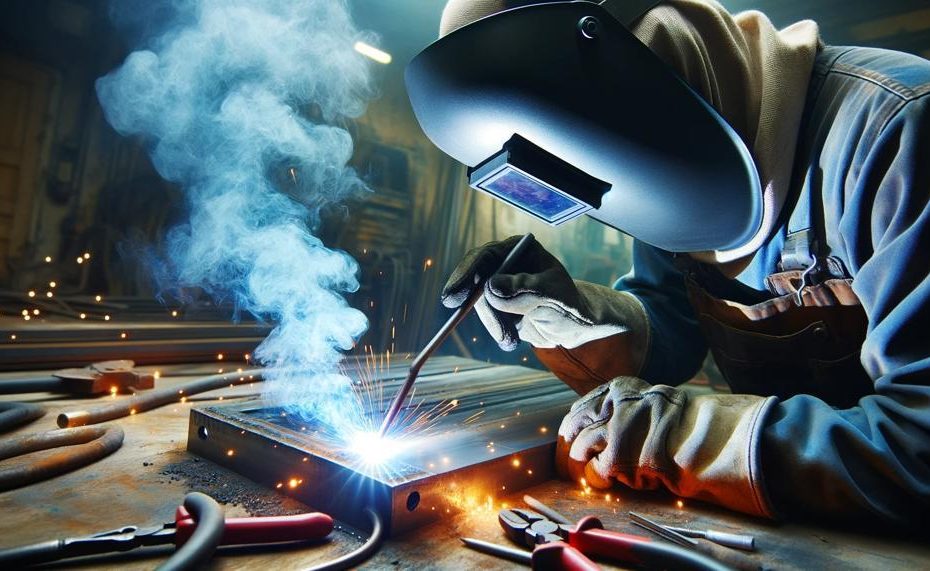As a beginner, you may have come across two popular techniques: MIG and TIG welding. While they may sound similar, these methods have distinct differences that can greatly impact your welding projects.
Whether you’re a DIY enthusiast or considering a career as a welder, understanding the nuances between MIG and TIG welding is crucial.
Let’s start with the basics:
- MIG (Metal Inert Gas) welding uses a continuously fed wire electrode and an inert gas to create strong and durable welds.
- TIG (Tungsten Inert Gas) welding utilizes a tungsten electrode and a separate filler material for precise and clean welds.
- For beginners, MIG welding is easier to learn and more forgiving, while TIG welding requires more skill and precision.
- If you’re working with delicate or thin materials, TIG welding is the way to go due to its ability to produce cleaner and more precise welds.
- On the other hand, if you’re dealing with thicker materials or larger projects, MIG welding is faster and better suited for the job.
Now that we’ve covered the basics, let’s take a deep dive into each technique to help you determine which one suits your needs best.
So grab your safety gear and let’s get started on our journey of exploring MIG vs TIG welding for beginners.
Contents
- 1 Mig Vs Tig Welding For Beginners?
- 2 Pros and Cons of MIG Welding for Beginners
- 3 Pros and Cons of TIG Welding for Beginners
- 4 Comparison of MIG and TIG Welding Techniques
- 5 Factors to Consider When Choosing Between MIG and TIG Welding
- 6 Tips for Beginners Learning MIG Welding
- 7 Tips for Beginners Learning TIG Welding
- 8 Conclusion
Mig Vs Tig Welding For Beginners?
When it comes to welding techniques, MIG and TIG have distinct differences that set them apart. These include the type of electrode used, the shielding gas, and the level of skill required.
MIG welding involves using a consumable wire electrode and a shielding gas to join two metal pieces together with a strong bond.
On the other hand, TIG welding uses a non-consumable tungsten electrode and a filler rod added manually to the weld pool, along with a shielding gas.
TIG welding requires more precision and skill compared to MIG welding, which is easier for beginners to learn.
The choice between MIG and TIG for beginners depends on several factors such as project goals, material thickness, and types of metals being welded.
For those just starting out, MIG welding is generally recommended as it is easier to learn and more forgiving in terms of technique. It is also faster and more cost-effective when working with thicker materials.
However, if a high-quality finish is required or working with thinner materials, TIG welding may be a better option. This technique allows for greater control over the weld pool and produces cleaner welds with less splatter.
Pros and Cons of MIG Welding for Beginners
MIG welding is a popular choice for novices due to its user-friendly nature and versatile capabilities. It also boasts several advantages, including speedy and efficient welding, precise and spotless welds, and cost-effectiveness.
However, there are also some drawbacks to consider, such as limited portability, difficulty in windy conditions, and the need for regular maintenance. It’s essential for beginners to carefully weigh these pros and cons before selecting MIG welding as their preferred welding technique.
| Pros of MIG Welding | Cons of MIG Welding |
| Simple to learn and use | Limited portability |
| Rapid and efficient process | Challenging in windy conditions |
| Versatile – can weld various types of metals | Not suitable for thin materials |
| Clean and smooth welds | Requires frequent maintenance |
| Economical compared to other processes | Restricted welding positions |
In brief, while MIG welding offers numerous benefits for novice welders, it also has its limitations. It is crucial for beginners to carefully evaluate their project requirements and skill level before determining if MIG welding is the most suitable option for them.
Pros and Cons of TIG Welding for Beginners
TIG welding, also known as gas tungsten arc welding, is a welding technique that uses a non-consumable tungsten electrode to create the weld. This method presents both pros and cons for beginners to consider.
Advantages:
- Precision and superior welds: TIG welding is renowned for its precision and ability to produce high-quality welds, making it a popular choice for intricate projects.
- Environmentally friendly option: By using an inert gas, typically argon, TIG welding protects the weld from contamination, resulting in a cleaner process with less environmental impact compared to other methods.
- Versatility in material usage: TIG welding can be applied to a wide array of metals and alloys, making it a flexible option for various projects.
- Heat and amperage control: With TIG welding, beginners have precise control over the heat and amperage produced, providing more flexibility when working with different materials.
- Reduced fumes and smoke: The use of inert gas results in fewer fumes and smoke during TIG welding, making it a healthier choice for both the welder and the environment.
Disadvantages:
- Slower speed and lower deposition rates: TIG welding may take longer than other methods, making it less ideal for larger or time-sensitive projects. It also has lower deposition rates, meaning it can be time-consuming to achieve the desired thickness.
- Contamination concerns: Poor gas coverage can lead to contamination issues, affecting the aesthetic of the weld.
- Polarity and balance adjustments: Beginners must remember the correct polarity for different metals and adjust balance settings accordingly. This can be challenging for those new to welding.
- Inconsistent filler rods: Different manufacturers may produce varying quality filler rods, resulting in inconsistent welds.
- Overheating risks: Overheating is common in TIG welding, especially when working with stainless steel or aluminum. This can cause discoloration or degrade properties in the welded materials.
- Oxidation potential: Improper back purging or gas leakage can cause oxidation or “sugaring” around the weld, impacting its strength and appearance.
- Technical skill requirement: TIG welding necessitates proper technique and skill to achieve consistent results, making it difficult for beginners to master.
- Cutting challenges: Cutting welded materials using the TIG welding process can be challenging without damaging the materials, making it a less desirable option for projects that may require additional fabrication.
Comparison of MIG and TIG Welding Techniques
When it comes to choosing between MIG and TIG welding techniques, there are a few factors to consider. MIG welding is commonly recommended for beginners due to its ease of use, faster welding pace, and lower upfront cost. However, TIG welding offers superior quality and cleaner welds, making it more suitable for intricate projects or thinner materials.
For example, if you’re working with thick steel or aluminum, MIG welding would be the better option. On the other hand, if you’re dealing with thin stainless steel or copper, TIG welding would yield better results. Additionally, TIG welding requires more skill and precision, making it a preferred choice for experienced welders.
While MIG welding is generally less expensive upfront, TIG welding can be more cost-effective in the long run due to its higher quality welds. It all depends on the specific project and the welder’s level of expertise. With dedicated practice and proper training, both techniques can be mastered by beginners.
| MIG Welding | TIG Welding |
| Utilizes a consumable wire electrode and protective gas | Requires a non-consumable tungsten electrode and may need a separate filler material |
| Perfect for thicker materials like steel and aluminum | Better suited for thinner materials such as stainless steel and copper |
| Uses direct current (DC) power source | Requires alternating current (AC) power source |
| Simpler to learn for beginners | Demands more skill and precision |
| Less expensive initial cost | Can be more cost-effective in the long run due to higher quality welds |
| Faster welding pace | Slower welding pace |
Factors to Consider When Choosing Between MIG and TIG Welding
MIG and TIG welding are two popular options, each with their own set of benefits and considerations.
When deciding between the two for novice welders, there are several key factors that must be taken into account: cost, ease of use, versatility, and desired end result.
Cost:
MIG welding is generally more cost-effective to get started with compared to TIG welding.
The equipment and materials needed for MIG welding are more affordable, making it a budget-friendly option for beginners.
Ease of Use:
MIG welding is easier to learn and perform compared to TIG welding. It requires less skill and precision, making it an ideal choice for beginners who are just starting out.
However, TIG welding offers more control and precision which can be beneficial for intricate projects.

Versatility:
TIG welding is highly versatile compared to MIG welding. It can be used on a variety of materials, including thinner metals and even non-ferrous metals like aluminum and copper.
This makes it a great option for beginners who want to work with different materials in their projects.
Desired End Result:
When choosing between MIG and TIG welding, consider the type of weld you want to achieve. MIG welding is generally faster and better suited for thicker materials, but may not provide as clean or aesthetically pleasing welds as TIG welding. On the other hand, TIG welding offers cleaner and more precise welds, making it a better option for projects that require a high level of detail.
Tips for Beginners Learning MIG Welding
Maintaining safety is crucial when learning any type of welding, especially MIG welding. Here are some essential safety precautions that beginners must take when embarking on their MIG welding journey:
| Understand the Risks | Prior to beginning any welding project, it is crucial to assess the site and identify potential risks. This includes checking for flammable materials, ensuring proper ventilation, and identifying any hazards that could cause accidents. |
| Inspect Equipment | Ensure that all equipment is in pristine working condition before starting a project. Check the welder, cables, and welding gun for any damages or defects that could lead to accidents. |
| Wear Protective Gear | Always prioritize your safety by wearing proper protective gear such as a welding helmet, gloves, and a respirator while welding. These will protect you from sparks, fumes, and UV radiation. |
| Work in a Well-Ventilated Area | MIG welding produces fumes that can be harmful if inhaled. Therefore, it is essential to work outside or in a well-ventilated area to avoid breathing in these fumes. |
| Prepare Materials Properly | Clean and prep all materials before welding to ensure a strong and clean weld. Remove any rust, paint, or debris that could affect the quality of the weld. |
| Use the Correct Filler Metal and Settings | The key to producing quality welds is using the correct type of filler metal and setting on your welder. It is crucial to consult the manufacturer’s recommendations for the specific materials you are welding. |
| Ensure Adequate Ventilation | Proper ventilation is vital to avoid the buildup of harmful fumes in your workplace. If necessary, use respiratory protective equipment to protect yourself. |
| Be Cautious with Carbon Dioxide | In MIG welding, carbon dioxide is often used as the shielding gas. However, it can displace oxygen and cause suffocation if used in an enclosed space. Always be cautious and use proper ventilation when working with carbon dioxide. |
By following these crucial safety precautions, beginners can effectively and safely learn MIG welding and avoid accidents or injuries.
Tips for Beginners Learning TIG Welding
Learning TIG welding may seem daunting for beginners, but with the right techniques and tips, successful and safe welding is achievable. Here are some important pointers for beginners embarking on their TIG welding journey:
- Choose the Right Equipment: Selecting the appropriate equipment is crucial for successful TIG welding. This includes a welder with the correct amperage rating for the materials being welded, as well as using the right tungsten electrode and filler rod.
- Practice on Scrap Metal: Before attempting to weld on a project, it is essential to practice on scrap metal with similar type and thickness. This allows beginners to hone their technique and become familiar with the specific processes required for TIG welding.
- Prioritize Cleanliness: A clean workpiece is crucial for achieving quality TIG welds. Any contaminants on the metal surface can result in poor welds or even failure. Be sure to thoroughly clean and degrease the metal before starting the welding process.
- Maintain Proper Posture and Grip: Consistent posture and a firm grip on the torch are key for precise control during TIG welding. Keeping a steady hand and maintaining a comfortable distance from the workpiece can help create clean and accurate welds.
- Understand Machine Settings: Having a good understanding of machine settings and their impact on the welding process is essential. This includes adjusting parameters such as electrode and workpiece distance, arc length, and filler metal addition rate.
- Master “Walk the Cup” Technique: The “walk the cup” technique involves moving the torch in an overlapping circular motion while feeding filler material into the joint. This method can help beginners achieve fast and high-quality welds.
- Be Patient: TIG welding requires patience and precision to achieve successful results. Beginners must take their time to ensure proper heat control and filler material addition for each weld.
- Wear Appropriate Protective Gear: Safety should always be a top priority when welding, and TIG welding is no exception. Ensure you have the right protective gear, including a welding helmet, gloves, and protective clothing. TIG welding produces high levels of UV light and heat, making proper protection crucial.
- Familiarize with Materials: Understanding the properties of the materials being welded is essential for successful TIG welding. Different metals may require different techniques and settings, so it is crucial to become familiar with the materials beforehand.
- Seek Guidance and Practice: Lastly, one of the most critical tips for beginners learning TIG welding is to seek guidance from experienced welders and practice regularly.
Conclusion
As a novice in the welding world, understanding the nuances between MIG and TIG welding is crucial. While these two methods may sound similar, they have distinct techniques and applications that can greatly impact your welding projects.
Whether you’re a DIY enthusiast or considering a career as a welder, it’s important to carefully evaluate factors such as project goals, material thickness, and personal preferences when deciding between MIG and TIG welding.
MIG welding offers simplicity and versatility for thicker materials, making it an ideal choice for beginners. Its ease of use allows for quick learning and application, perfect for those just starting out in the world of welding.
However, if you’re looking for precision and superior quality welds for thinner materials or intricate projects, TIG welding may be the better option. It requires more skill and practice but can result in impeccable welds that are almost invisible.
Both techniques have their own pros and cons that should be weighed before making a decision. But don’t let this overwhelm you – with dedicated practice and proper training, beginners can master either MIG or TIG welding.
So grab your safety gear and start exploring these two popular techniques to discover which one suits your needs best.





